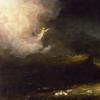Harvard Art Museums’ Renovated and Expanded Facility to Open November 16, 2014
- CAMBRIDGE, Massachusetts
- /
- March 11, 2014
The Harvard Art Museums—comprising the Fogg Museum, the Busch Reisinger Museum, and the Arthur M. Sackler Museum—will open their new Renzo Piano-designed facility to the public on November 16, 2014.
The renovation and expansion of the museums’ landmark building at 32 Quincy Street in Cambridge, Mass., will bring the three museums and their collections together under one roof for the first time, inviting students, faculty, scholars, and the public into one of the world’s great institutions for arts scholarship and research. In the Harvard Art Museums’ new home, visitors will be able to explore new research connected to the objects on display and the ideas they generate in the galleries; gain a glimpse of leading conservators at work; and in the unique Art Study Center, have hands-on experiences with a wide range of objects from the collections.
“We are eagerly anticipating the opening of the new Harvard Art Museums facility,” said Harvard President Drew Gilpin Faust. “Renzo Piano has designed a building that is as beautiful as the works of art it will house and as thoughtful as the people who will work and learn within it. It will expand the ways in which we use art and art-making as part of the curriculum, and it will invite our neighbors and visitors to enjoy some of the University’s unparalleled treasures.”
The design for the new Harvard Art Museums creates new resources for study, teaching, exhibition, and conservation. The facility’s center, within the restored Calderwood Courtyard, will be a hub of activity and circulation. Mirroring an Italian piazza, or city square, the Calderwood Courtyard has been extended upward with glass arcades on the upper three floors and a new glass roof allowing controlled natural light into the heart of the building. Visitors can pass through the museums’ ground-floor public spaces, entering from either a new Prescott Street entrance or the original Quincy Street entrance, and can easily navigate the six levels of public space including galleries, the Art Study Center, classrooms and lecture halls, and a top floor offering views both into the heart of the facility and outside to Cambridge and Harvard Yard. The ground floor of the building, including a shop and cafe, will be open to the public without the purchase of admission.
The Harvard Art Museums have internationally renowned collections, which are among the largest art museum collections in the United States. Together, the collections of the Fogg Museum, the BuschReisinger Museum, and the Arthur M. Sackler Museum consist of approximately 250,000 objects dating from ancient times to the present, including objects from Europe, North America, the Mediterranean, and Asia across a variety of media.
The facility provides new and versatile platforms for accessing the collections: three distinct art study centers, special exhibition spaces, and the University galleries, which are programmed in consultation with faculty to support specific coursework or in partnership with other Harvard museums. The new exhibition galleries are designed specifically to create places for close engagement with individual works of art—for both the Harvard University community and the general public. Diverse, flexible spaces enable curators, students, and faculty to use the collections in ways that foster more dialogue and invite juxtapositions between objects from different cultures, time periods, and media. The renovation and expansion project has increased gallery space by 40 percent, for a total of approximately 43,000 square feet.
“We knew that we had an opportunity to redefine the Harvard Art Museums as an accessible and connected 21st-century facility for teaching and learning, so we engaged Renzo Piano to design a building to implement that vision,” said Thomas W. Lentz, Elizabeth and John Moors Cabot Director of the Harvard Art Museums. “We asked him to design it from the inside out—to create a new kind of laboratory for the fine arts that would support our mission of teaching across disciplines, conducting research, and training museum professionals. We also wanted to strengthen the museums’ role as an integral part of Cambridge and Boston’s cultural ecosystem. We look forward to welcoming students, faculty, and staff at Harvard, our Cambridge friends and neighbors, the entire Greater Boston community, and travelers from afar into our new home this November.”
Providing opportunities for the close, sustained viewing of works of art has long been central to the Harvard Art Museums’ mission of teaching and research. Only a small percentage of the museums’ collections can be displayed in public gallery spaces at any given time. Designed to offer an environment for individual study, the Art Study Center will provide distinct learning opportunities for students, faculty, and the public through the close examination of original works of art from the
collections of the Fogg, Busch-Reisinger, and Arthur M. Sackler museums. Each of the three museums has its own dedicated art study center offering access to thousands of works of art across all media, including Greek vases, Roman bronze figurines, Byzantine coins, Chinese jades, Japanese surimono prints, Islamic miniatures, Rembrandt etchings, Paul Gauguin still lifes, David Smith sculpture, photographs by Diane Arbus, Lyonel Feininger drawings, or Joseph Beuys’s multiples. Visits can be arranged through advance appointment. The Art Study Center as a whole (including two seminar rooms and large reception and orientation areas) totals approximately 5,000 square feet and inhabits the fourth floor of the new facility, making it unique in size and scale among U.S. museums.
To date, the Harvard Art Museums have raised $237 million, 95 percent of the initial $250 million fundraising goal. Leadership philanthropic investments have been made by many significant, long-time benefactors of Harvard, including Emily Rauh Pulitzer and Joseph Pulitzer, Jr., David Rockefeller, Richard and Ronay Menschel, and the Calderwood Charitable Foundation, among many others. Recent support includes a $5 million gift from the German Friends of the Busch-Reisinger Museum; a $2 million gift from Robert and Betsy Feinberg to name the Feinberg Art Study Center; and a $3 million gift from Marguerite Steed Hoffman to name the Art Study Center reception area. The project has also received support from the Massachusetts Cultural Facilities Fund, a state-funded agency, in recognition of the project’s value as a new public education resource. All funds contributed have been dedicated either to capital costs for construction and renovation or to building the endowment for operating costs.
















